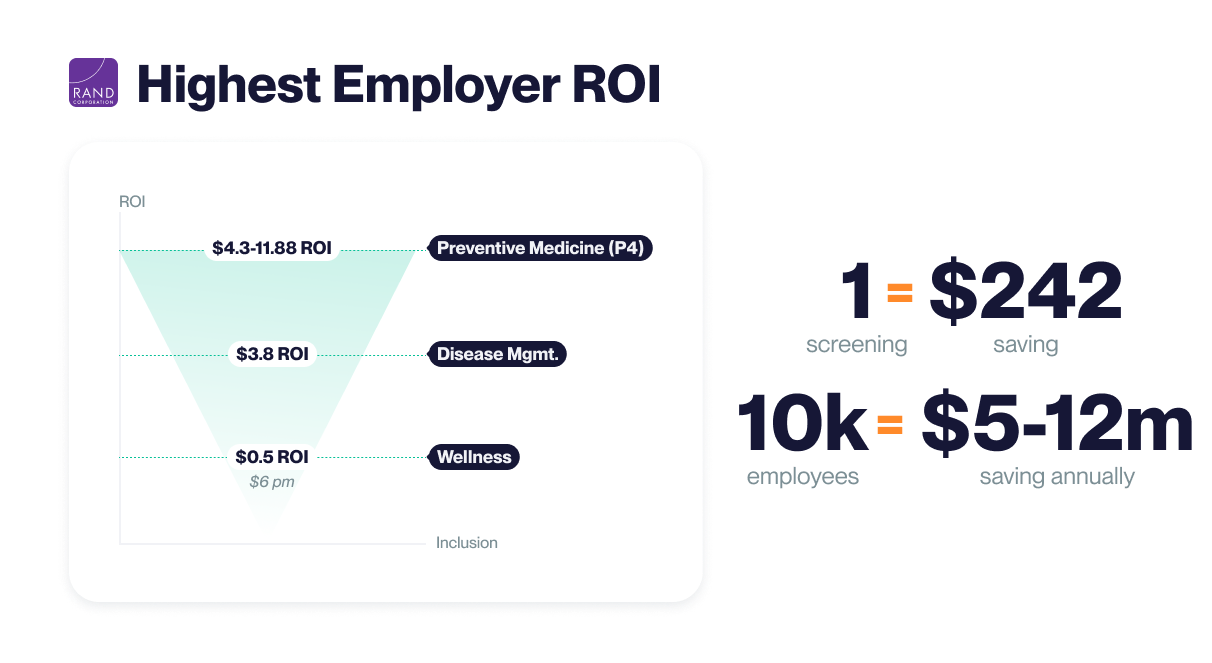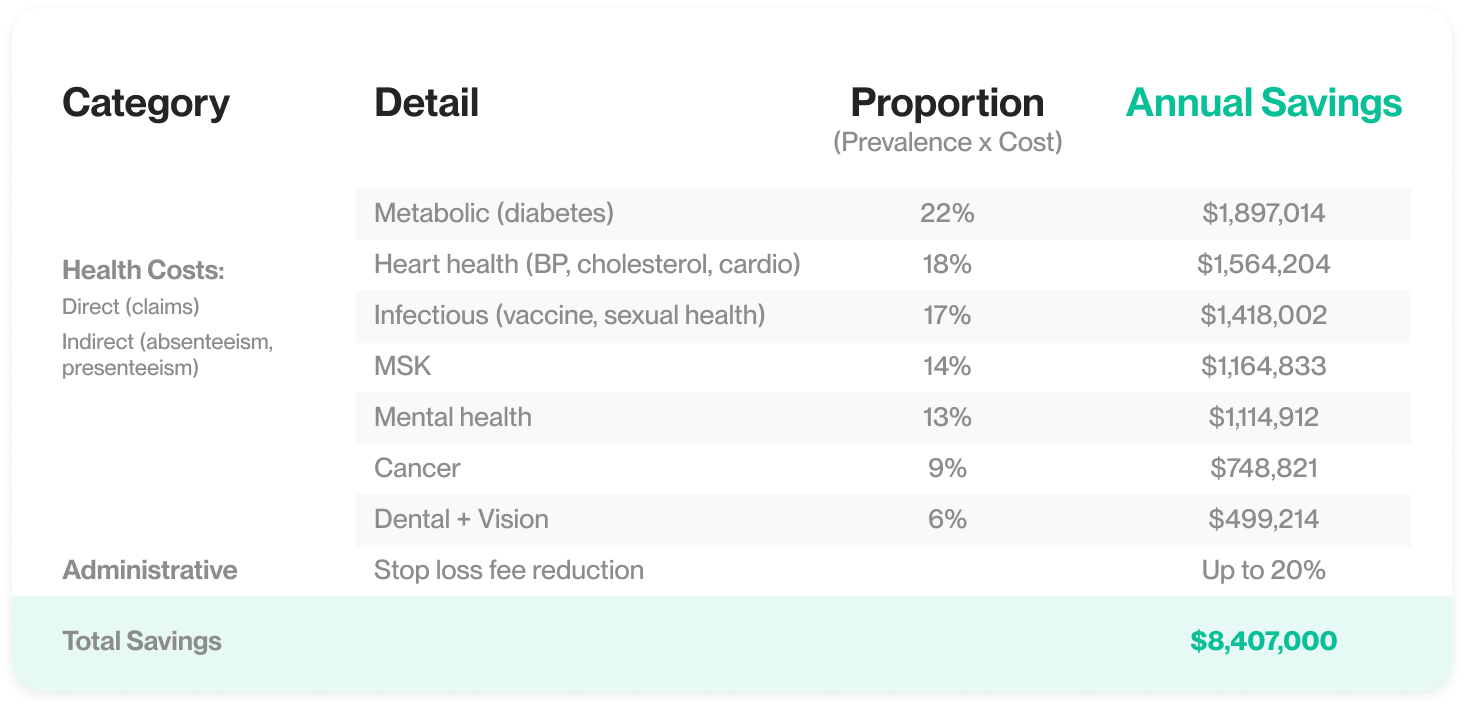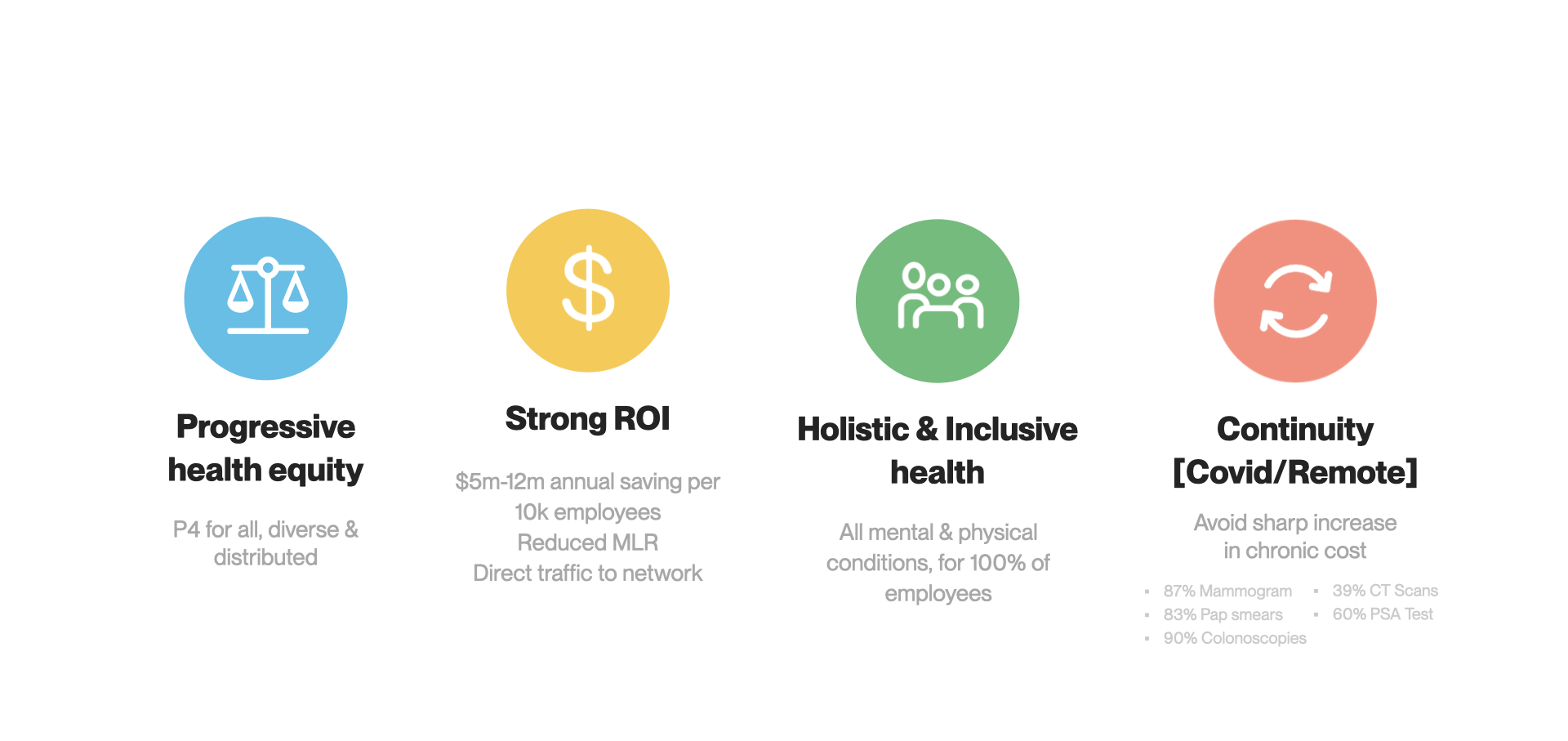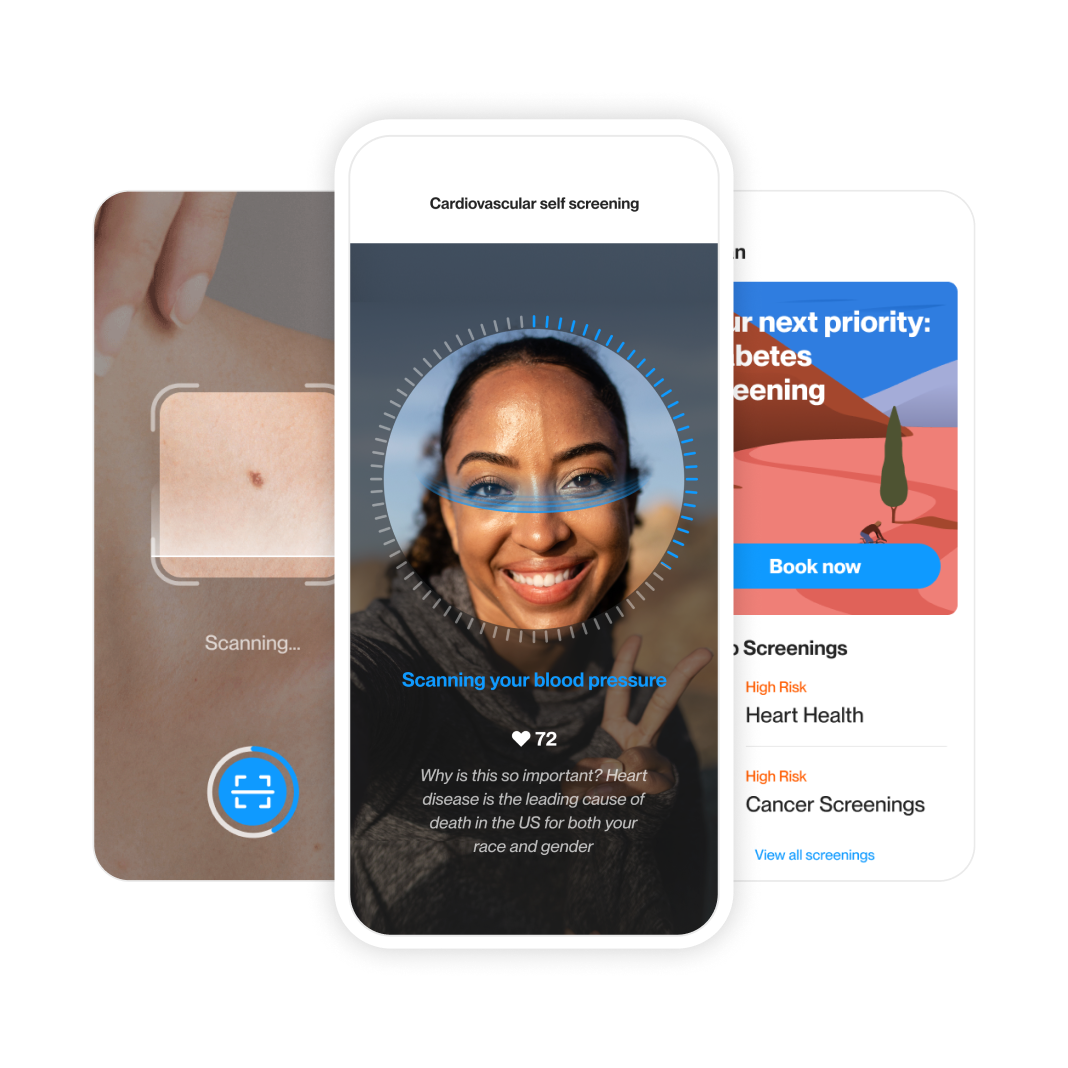Why P4 medicine is the future of healthcare:
A deep dive into P4 medicine and why it’s a game changer for your healthcare ROI
Here’s a stat that will shock many organizations: A recent RAND showed that giving your population easy access to systematically complete all of their personalized screenings is, beyond a shadow of a doubt, the best way to immediately cut healthcare costs.
RAND found that for an organization with 10,000 individuals, a good preventive medicine program, that is focused on completing all high priority personalized screenings & immunizations, saves between $5 million and $12 million each year.
It’s no wonder that more and more organizations are making preventive medicine – especially “P4” medicine – a priority.
How is clinical preventive medicine different from wellness?
Chronic conditions are becoming increasingly prevalent, and the cost of healthcare is rising sharply for organizations.
When insurance costs rise (and they’re definitely rising – total premiums have increased by 22% since 2016), lots of organizations started investing in wellness programs – initiatives that get members to exercise more, and eat healthier.
While wellness initiatives are very important, they only deliver $0.50 per dollar of investment. Clinical preventive medicine, by comparison, delivers $4.3-11.88 per dollar of investment by focusing on the screenings and immunizations that each person needs to complete, systematically, based on their individual risk factors

Health program ROI is based on the inherent health impact of the offered services, as well as the inclusiveness of the program (% of members to whom it’s relevant).
Wellness programs tend to attract people who are already relatively healthy therefore less inclusive. It’s difficult to change people’s behavior, get them to run three times a week or change their eating habits. Also, it won’t protect them from a family history of cancer, cardiovascular disease, depression, and many other diseases.
Clinical preventive medicine is proven to have the highest health impact, preventing 85% of diseases for people who complete their screening and immunizations on time, systematically. Some diseases can be completely prevented and in others, a more severe disease is prevented with early detection, by taking action before symptoms even occur. Inclusion wise, this is relevant to 100% of members, at any age, healthy and chronic.
Another amazing fact is that only 8% of adults complete their high priority screenings on time, systematically, without delays. This is mainly due to the high complexity and effort that is required to complete it on time, as well as the fear of cost although ACA made it free when done in-network at the right frequency.
With the rise of chronic conditions organizations also offer disease management programs for people who suffer from a chronic condition. This is an important way of supporting those with chronic conditions, and can certainly bring down costs with $3.8 ROI, but it’s only relevant for those with a specific chronic condition which is supported by the given program, therefore limited inclusion wise.
While wellness and disease management are extremely important, clinical preventive medicine is the strongest proven vehicle to change the trend of chronic conditions, and drive the highest healthcare savings as of the first year.
P4 is the answer to the cost burden of chronic disease
P4 medicine is a framework that is becoming increasingly popular with some of the world’s most advanced companies. P4 stands for medicine that is:
- Personalized – Care is tailored to individuals according to their personal risks (i.e., family history, health history, ethnicity, gender, lifestyle, etc.). No two P4 plans are the same, and the whole experience of accessing healthcare is completely adapted to the individual’s needs.
- Predictive – It identifies the diseases a member is at risk of developing and plans in advance how it can be avoided.
- Proactive – P4 medicine makes it easy for individuals to take an active role in their own care. That means that smart technology is used to automate actions that people are used to doing today, removing most of the friction. For example, getting a plan that is adapting to your profile automatically, enabling you to use the mobile phone as a screening device, and automating scheduling doctor’s appointments for you.
- Preventive – It focuses on recognizing personalized risks and mitigating diseases before symptoms occur, and before they become expensive and dangerous.
What is the ROI of investing in P4 medicine for employers and insurers?
There’s a common misconception among organizations that investing in clinical prevention won’t pay off in the short term. Let’s debunk that misconception.
In a conservative estimate done by RAND, it’s shown that getting one individual to attend just one screening saves you an average of $242 in healthcare costs.
And that’s per screening per person. Let’s look at what this means for a population of 10,000 lives – getting 50% of individuals to attend 35% of the screenings that each of them needs on time and systematically can generate savings of $5m-$12m every year.
From our own experience at Livez, we’ve seen that getting people to attend their personalized screenings and immunizations regularly and on time can bring healthcare cost inflation down from double digits to single digits.

Here’s how P4 medicine can save you money this year (by disease):
Metabolic (Diabetes)
- An individual with diabetes cost an organization $16,752 in direct and indirect costs. This is 2.3x higher than those without diabetes.
Heart Health
- An individual with heart disease costs an organization $2,200 per year in direct and indirect costs
- Every individual with hypertension costs $1920 their organization every year
Infectious Diseases
- The flu season costs US employers more than $11 billion per year in direct and indirect costs
- Employers gain 4-6 days of productivity, just by making sure employees get their flu immunization systematically and on time.
- Routine vaccines have similar or better return on health savings as chronic disease
Musculoskeletal Disorders
- Employees with MSK issues miss 2x the amount of workdays as the average employee
Mental Health
- Over 70% of people who identify depression risk on time see a significant improvement in their mental health
- You can save an average of $10,836 a year on mental health costs per employee with early detection
Cancer
- Employers can save $15,000-$30,000 per employee through early detection of prostate cancer
- Early detection of cancer leads to over 90% successful treatment for the most common cancers
- Cancer costs projected to increase 34% from 2015-2030 and is now seen as the top driver in healthcare costs by employers
Other ways that preventive medicine improves ROI
Fewer sick days
- By encouraging employees to take small amounts of time off work to make use of preventive medicine services, you’ll greatly reduce the likelihood that employees will get seriously sick. And that means a huge reduction in the number of unexpected sick days taken by employees each year.
- Those days add up; employers currently lose $36.4 billion a year to absenteeism that results from chronic disease.
Emergency room visits
- The average ER visit for an insured patient currently costs around $2,200; those savings quickly add up for employers.
Lower stop-loss fees
- If, like many employers, you’ve protected yourself from large individual or aggregate claims with stop- loss protection, you’re likely to see an immediate financial impact from P4 medicine.
- Employers that have a holistic screenings program in place see a 20% reduction in stop loss premiums.
That’s why more and more employers and health plans partner with progressive services like Livez to drive P4 medicine at scale. This is aimed at early detection of 85% of diseases across a diverse & distributed workforce, by using employees’ mobile phones as a screening device.
Livez helps to ensure:
- Health equity – It’s easy for anyone, anywhere to access the healthcare they need. Personalized plans ensure that every employee gets the care that they need, based on their individual risk factors, health plans, geo-location, and preferences.
- Strong ROI – holistic screenings and immunizations, adapted to each employee’s risks, using a mobile 1st platform, saves $5m-$12 yearly per 10k employees.
- Holistic Solution – personalized early detection of all physical and mental conditions from one mobile platform (including cancers, heart, diabetes, MSK, depression, anxiety, addictions, vision, dental, etc).
- Continuity of care for a distributed workforce – Livez constantly adapts to each employee risks, health plan changes, geo location, benefits eligibility, employer ecosystem services, and providers availability to enable continuity of care, acting as an automated lifelong prevention tool, mitigating diseases before symptoms occur.

Make P4 medicine the backbone of your healthcare plan
When your employees are wrestling with acute and chronic diseases, it can have a huge impact on both their well-being and your health spend as an employer.
The good news is that, with effective P4 medicine, many of these diseases can be prevented, or at the very least their impact can be minimized. With the right employer P4 medicine plan, you’ll be able to help protect the health of your employees, see significant ROI, and avoid spiraling healthcare costs.
It’s a win-win for you and your people – and one that’s going to become the norm for employers.

